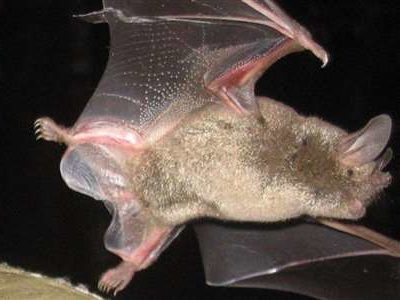As our only native land mammal, bats are both vulnerable to introduced mammal predators and potentially vulnerable to the methods used to control those predators. It is critically important therefore, that any ‘collateral’ harm done by the control method is significantly less than the damage that would have been done by the predators that are being removed. The long-term benefits must outweigh any short-term costs – and we need to know exactly what those costs are.
Lesser short-tailed bats in the Eglinton Valley, Fiordland have been monitored in a long-term study since 2008. When an aerial 1080 operation took place in the valley on 12 December 2014, DOC scientists Hannah Edmonds, Moira Pryde and Colin O’Donnell took the opportunity to observe the response and survival of the bats during and after that operation. They then compared bat survival post-1080 with normal bat survival statistics obtained in the previous seven years.

The results of their study have just been published in the New Zealand Journal of Ecology and are significant for several reasons, as the researchers explain:
“This is the first study to observe the response of a high proportion of individually marked lesser short-tailed bats to an aerial 1080 cereal pellet rodent control operation. Previous studies of potential effects of 1080 on bats were operations designed for controlling brushtail possums at a much higher bait sowing rate than was used in the Eglinton Valley. Furthermore, the possum-control operation monitored a smaller number of unmarked bats returning to a roost one night after bait deployment.”

The 2014 aerial 1080 operation was to control ship rats during a beech mast, with cereal pre-feed and then 1080 pellets, spread by helicopter over an area of approximately 10,939 ha. GSP technology was used to control bait release along parallel flight paths. The cinnamon-lured bait was loaded with 0.15% w/w 1080 and applied at a rate of 1kg per hectare.
“In this paper, we report on the survival of a large sample of lesser short-tailed bats in the valley before, during and after bait application and compare this with the annual survival rate over a 7-year monitoring period… Lesser short-tailed bats (Mystacina tuberculata) may be vulnerable to secondary poisoning from 1080 because they feed on invertebrate prey on the ground that may have consumed toxic bait… Lesser short-tailed bats are not known to feed directly on carrot or grain based toxic baits.”
The individually marked bats were monitored immediately after the 1080 operation and were then checked one week later and checked again a month later, in January 2015. The monitoring was extensive. As well as netting individual bats and monitoring their health, a number of other techniques were also employed.
“We also climbed and checked other roost sites for dead or dying bats (on ground and in roost cavities) every three days after the 1080 operation, until baits were deemed non-toxic. We used a wireless inspection to inspect the interior of roost cavities. Activity at roosts was recorded using a custom-built infrared camera with SD recorder each night from 11 to 16 December 2014. Samples of guano were also collected at several roost sites to test for traces of 1080 toxin.”
For those worried about the impacts of 1080 on our native bats, the results should be reassuring.
“No symptoms of sub-lethal exposure in free ranging bats were detected and survivorship was high: 764 of the 771 marked bats (99.1%) recorded in the pre-monitoring period were still alive one week after toxin application and a record number of 1731 marked bats were recorded emerging from a single roost tree in January 2015.”
One newborn bat pup, with placenta still attached, was found dead under a roost tree and was found to have low levels of 1080 present in muscle tissue. Whether this was related to its death could not be determined. By comparison, previous research has estimated that bat mortality during rat irruptions is 20-30%.
“Annual survival of adult females between 2008 and 2015 was high with the exception of 2008 [a heavy mast year] when annual survival was significantly lower than average. The survival rate in the 2015 season following the 1080 operation was 0.915, which was above the average survival rate of 0.83 over the 7-year monitoring period.”
The researchers concluded that overall, the 2014 aerial 1080 operation benefited Eglinton Valley’s short-tailed bats.
“Any immediate impact of 1080 was assessed as minimal because the calculated annual suvival rates were high (91.5%). We conclude that survival of the population was likely enhanced by the large scale 1080 operation.”
The full report is published in the NZ Journal of Ecology and is freely available online.

